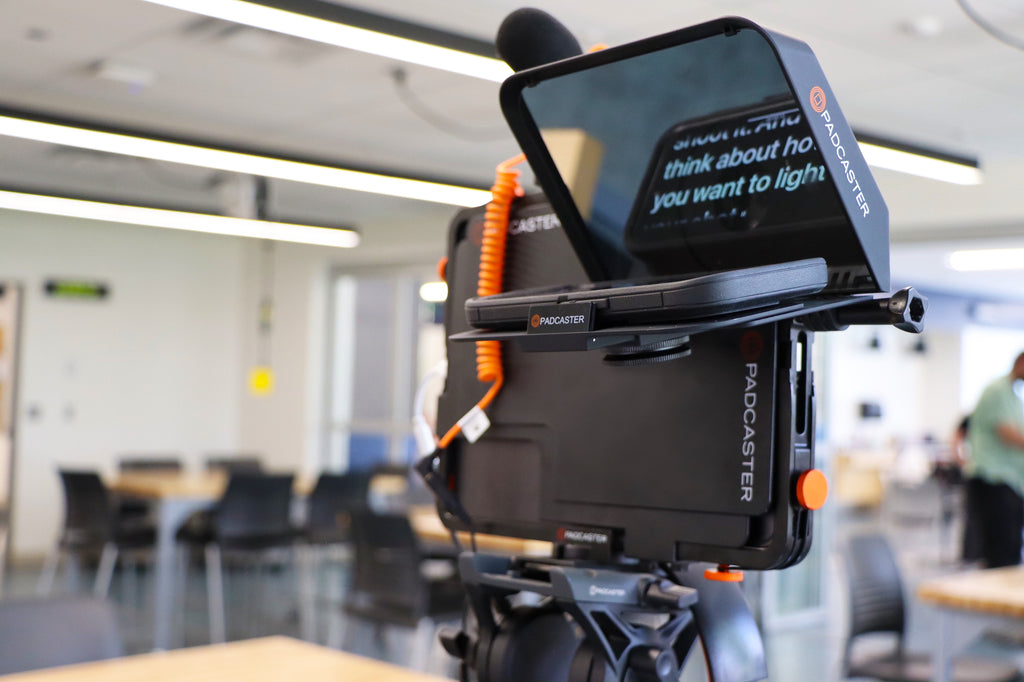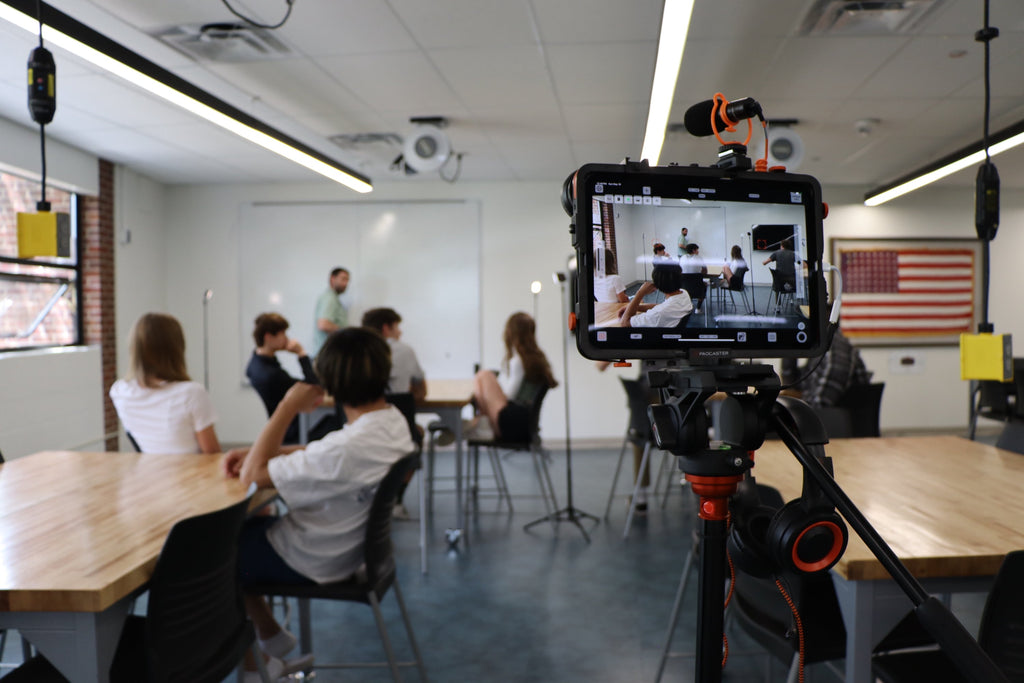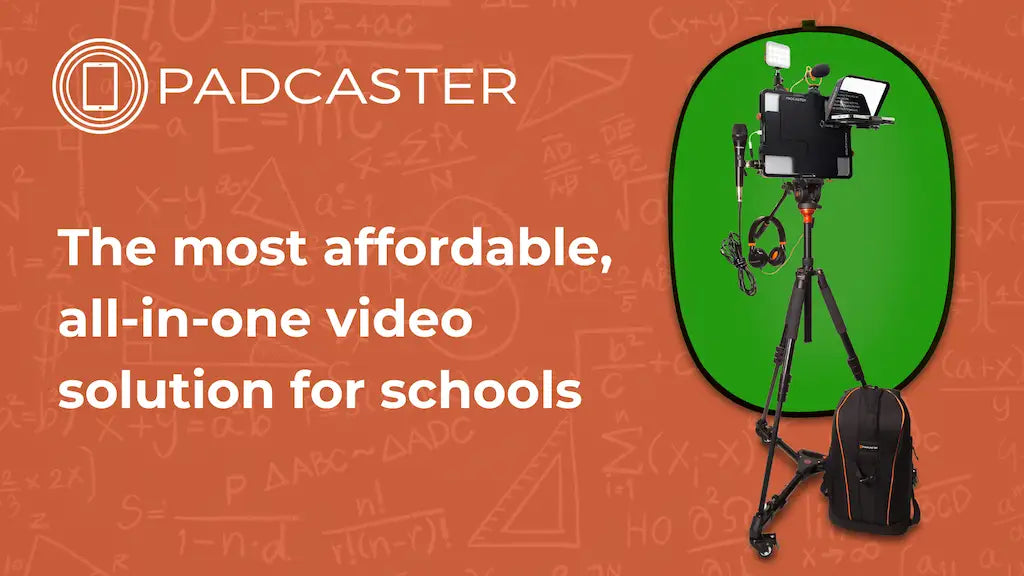
This March, Padcaster had the opportunity to sit down with Violet Christensen, a Learning and Technology Coach in the St. Vrain Valley School District in Longmont, CO, to learn all about how she utilizes Padcaster in her district. Violet’s career in EdTech centers around technology integration, instructional learning, cognitive coaching, modeling, and co-teaching. She teaches video production and green screen technology to students of all ages as well as other educators and administrators.
You can listen to Padcaster's interview with Violet here or read her Q & A below:
Tell us a little background about St Vrain Valley School District’s dedication to technology in education and your involvement.
St. Vrain has committed to a long term strategic plan for technology implementation and integration. This district is a pillar in public education and innovation. In August 2018 I was hired as an Elementary LTC (Learning Technology Coache). I knew from the first phone interview this would be a dynamic position where I would be pushed to grow, learn, and innovate everyday! As an LTC I help with cognitive coaching cycles, video coaching cycles, modeling, co-teaching, technology integration and so much more.
As a Learning Technology Coach who exactly are you coaching?
As an LTC, my role affords me the opportunity to work with teachers, students, administrators, district technologists, the Office of Professional Development, paras, specialists and any district employee within the school network who needs my support. Additionally, I collaborate with a network of Learning Technology Coaches, Instructional Technology Coordinators, and STEM Coordinators to elevate best practices for teaching and learning across the St. Vrain Valley School district.
Why do you think it’s important to teach technology, especially video production, to young students?
I believe it can heighten the educational experience immensely when we teach children a skill base in technology and video production throughout their formative years. This helps to prepare them for a future workforce that is most likely hard for us to even conceive at this moment in time. The key to learning is the content, not the technology. The technology is a dynamic tool that can enhance the experience of learning the content and also a means to integrate creation along the way. Students of today are digital natives and have the amazing ability to pick up innovative tools and gain mastery in no time at all. The moment the Padcaster is rolled into a room the learners get excited about what they will launch into creating and designing today! Students are invested in their video production projects because they are all about their student voice and being able to share it with real and authentic audiences.
When I watch Kindergarteners starting in video production it makes me sit back and think about what are the skills and content these students might be able to master by the time they are at the high school level. I am proud to work in a district that truly provides innovative options for students throughout their educational career. I love knowing that no matter how far I push the little ones in their learning that they will continue to be pushed all the way through their academic career in St. Vrain. I can not wait to see what marvels these little learners create in their lifetimes! I cannot even conceive how they will change our world!
How were you first introduced to Padcaster and green screen?
I was introduced to the Padcaster and green screen shortly after I joined the St. Vrain Learning Technology Coaches in our Office of Professional Development. Upon being hired, I asked my new principals if there was anything I could do to prepare for the coming year. I was told that a Padcaster system had been purchased for each elementary school and I should familiarize myself.
The more time I invested into the Padcaster and green screen the more I realized the power of these tools in the classroom and beyond throughout the district to benefit educators and students alike. I have formulated professional development around this tool, led it, and integrated it with teachers and students.
I also had the opportunity to train our district technologist team around the Padcaster tool so that they can better support teachers throughout the district with their usage. St Vrain has even purchased a Padcaster for our Professional Development Department to produce high quality interviews, and be able to film educators for various purposes.
You had mentioned that you create green screen projects with students in K-5. What is it like teaching over such a wide range of ages?
I spent a decade teaching third grade prior to finding this tremendous educational position. I will always hold that age group close to my heart, but it has been such a fun adventure exploring green screen projects with various grade levels. It is incredible to see the progression of learning and the building up of this skillset over time. One thing I truly love about small group projects with video production is that everyone can shine and contribute in the way they want to and feel comfortable. If everyone wants to be filmed, they can. If some students want to focus more behind or in front of the camera, that is okay too. They are all working together towards a common goal of producing a quality product. I think video production is an incredibly powerful tool to teach these skills.
What was it like introducing green screen technology to such young students? How did they react?
Most Kindergarteners are nervous the first time and then act like pros by round two. They can clearly infer that the Padcaster is an adult technology tool. Most feel privileged and excited to use this tool. The younger students love to feel like they have such an important job to create a movie. When we build in and scaffold their learning over time so that they can be successful, they truly can create powerful video productions. I also love that we can create these quality productions to share with their families or the community.
What areas of video production do you focus on with the different age groups?
In the primary years I really focus on students learning the basics of filming and deeply integrating oral presentation skills. I make sure they have a basic understanding of the Padcaster tool and the iPad for filming. One consideration with our wee media producers is that we as coaches have to help them work on eye contact, speaking clearly, and keeping their thoughts aligned with what they want to share. I believe that if we start presenting more frequently at a younger age then less students would be so fearful of oral presentation in later years.
In the intermediate grades, we work to enhance and refine our filming and oral presentation skills as well as develop scripts or storylines further than in younger grades. The learners also spend more time on script development, refining and developing how you or your team presents a story or information, and how to work as a cast and crew. The ownership of all aspects of media production can be transferred to student hands, and usually faster than an educator might expect. They are empowered with voice and choice on how they want to do this work.
What were the challenges and rewards of teaching green screen tech and video production to kindergartners vs. older students?
I think both groups of students are rewarding to work with. I have the ability to collaborate with students to make their visions into realities, and I get to teach them to use the tools to make it these things happen - this is my dream job.
With intermediate learners, the hardest part about this process is deciding on a group vision for the students’ production and being able to manage all of the students’ dynamic ideas and contributions. For instance we utilized the Padcaster to film a professionally edited rap video of the human skeletal system!
The highlight for me came when the class viewed the finished video together for the first time; the sense of comradery that fell over everyone in the classroom was palpable! Ultimately, this student-created video would go on to receive over a thousand likes and retweets on Twitter.
In a Kindergarten class, the scaffolding of the process takes longer to build up and the students require more monitoring within the process, but they can create their own masterpieces too! I find that it is best to have them practice with recording movies first and then watching their playback tapes. The Padcaster can be a huge help since the little ones have shaky hands. With one of our Kinder projects we were able to put them within their own hand drawn weather forecasts. There is nothing better than watching back a production with a younger student. They are so enamored with themselves!
What is your focus when coaching adults in media technology?
My main focus when coaching adults in media technology is to honor where they are as a learner. You need to grow from where they are to build a steady foundation in technology integration. I always want to be mindful of them as learners and then I try to flex my teaching and coaching to meet their needs. We have to start with the why. We need to know what the objective or learning target is first, and then build backwards from there. We want the learning to be focused on the content and then naturally align technology tools to enhance the learning experience.
The most important aspect of technology learning to me is to let people get their hands on the tech and try it out themselves. If they learn to drive the technology then they are more apt to utilize it in the future and dive deeper with its capabilities.
Do you have any advice for other media educators interested in incorporating video production into their curriculum?
My biggest advice for other media educators is to trust the potential and budding capabilities of the students. Do not feel like you need all of the know how or the technical skills. If you have a problem or question, the resources are likely within the students in your room to guide you through it. Empower your students with the tools and be amazed at what they try, tinker with, create, and produce. It is about how as educators we can invigorate the spark for learning in every child that passes through our classrooms.
I feel like the instructional content is the foundation, and the technology tools, such as the Padcaster, are the means to engage and invigorate the learning of that content. Make it about the learning objectives and success indicators first. Then when the backwards design process is being utilized, you try to keep the tech tools you have in mind to shake up, deepen and extend that learning in meaningful ways.
Do you have any future media projects that will involve the Padcaster Studio? If so what are they?
I am so lucky to have the opportunity to teach about the power of media technology and engagement this summer at St. Vrain’s Camp EmpowerED Event that will be taking place in late May. There, I will be able to teach educators from our district and around the state with the help of a teammate, Courtney Groskin, to help invigorating teaching practices around green screen and Padcaster Technology.
Beyond that...I know that I do have future media projects, but I do not think I can tell you specifics, as they are still being dreamed up in the minds of students and teachers. I have projects and video coaching cycles on the books with teachers at Legacy Elementary, Centennial Elementary and Prairie Ridge Elementary. I have to shout out to the amazing educators and school leaders at these schools and within our district who trust me with their students daily. They are the ones who provide the opportunities for students to use green screen technology and video production. They make this learning possible for their students and I simply assist!
Need More Information?
Fill out the form here to get in touch with a member of the Padcaster Team.


